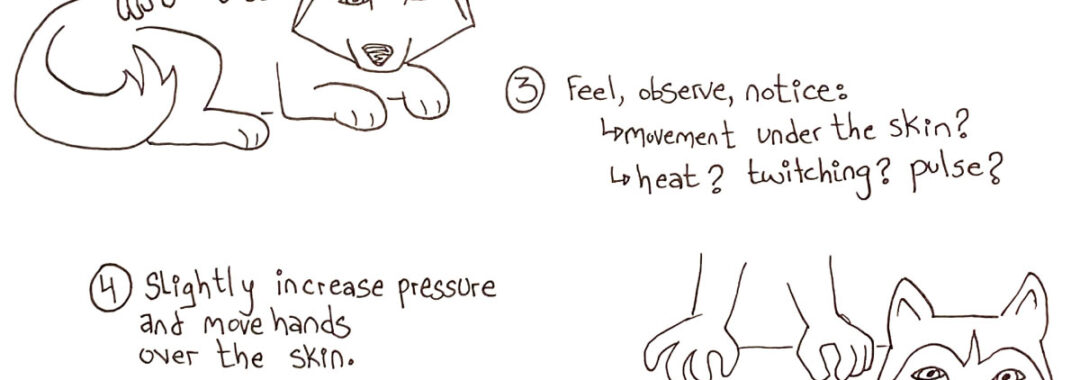Even though we pet our dogs daily, we rarely do so while paying full attention to what we feel under our hands. I encourage you to get to know your dog’s body by spending five minutes each week exploring their body with your hands and noting your observations in the body provided.
What are the benefits of getting to know your your dog’s body?
Knowing what is normal for your dog’s body will help with:
- injury prevention
- noticing problems as they appear
- presenting your observations to your vet
- becoming more in tune with your dog’s body
How do I get to know my dog’s body?
At least once a week spend a few minutes joining your dog for a short bodywork session. Follow the instructions in the video below or in the graphic.
Pay particular attention to areas of heat, cold, tension, weakness, twitching or pain. Log your observations in the Body Map Journal.
The emerging patterns will give you a better sense of how your dog’s body is feeling and what areas might need more attention. This is also an excellent tool for young and active dogs – it will help you learn what is normal for them and you will be able to spot issues much sooner.
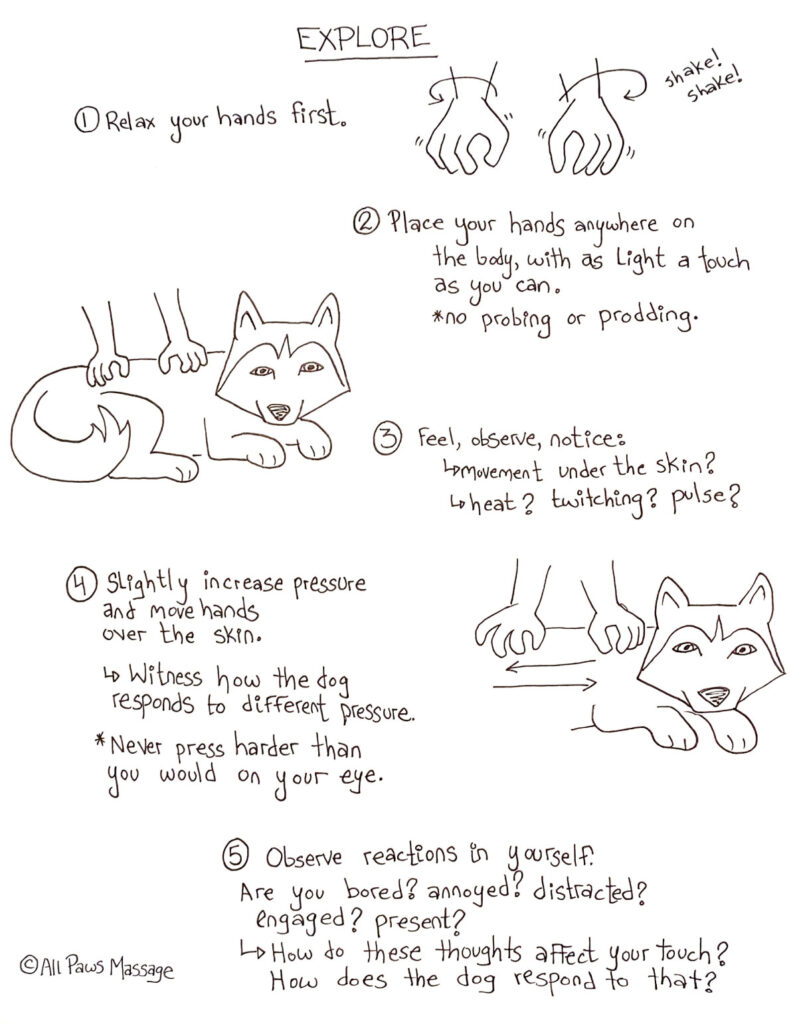
What are we looking for?
So now that we know how to mindfully assess our dog’s body. Let’s talk about some of the red flags to look for.
Heat
The human hand is adept in noticing even the smallest change in temperature. As you explore your dog’s body you might find areas of heat. Those can be perfectly normal such as warm muscles after excersise, or might be a red flag worth noting on the body map.
Increased blood flow or inflamation are often the main causes for increased heat in a specific area. Inflammation can be related to:
- Injury
- Arthritis
- Infection
Common areas where you might find heat:
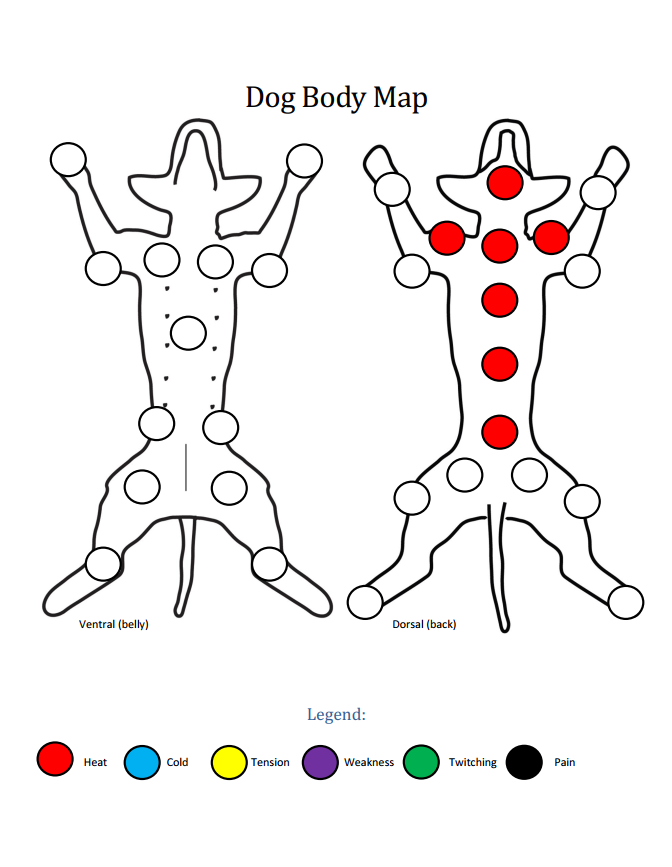
Cold
Cold can be tricky to spot. Each time we run our hand over the body we effect change. This is specially true when trying to detect cold areas, the more often we touch it the more likely we are to warm it up. So remember to trust your hand and intuition.
Cold areas are most commonly related to decreased circulation.
There are a number of reasons why a certain body part might feel cold. It may be due to circulatory, hormonal, or neurological issues. Common causes for a localized decrease in body temperature:
- Low circulation
- Edema
- Scar tissue
Common areas where you might find cold
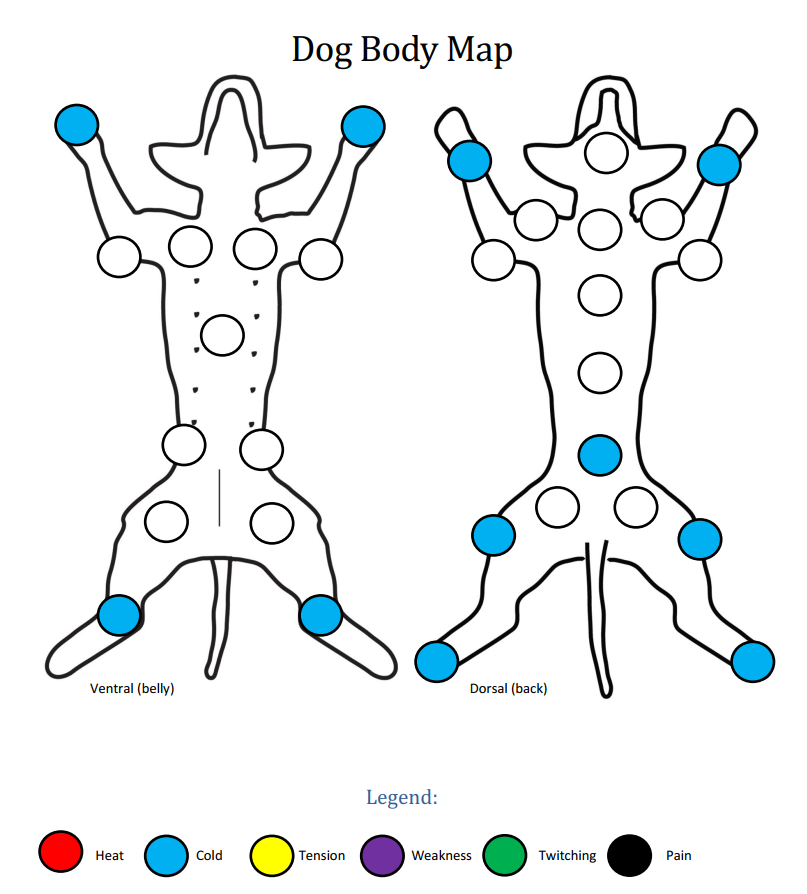
Tension
Tension is a broad subject and recognizing it can take a bit of practice, but if we work with our dog regularly, we will be able to recognize the difference between normal and tight muscles. As you run your fingers over their muscles, you may notice: tight or stuck tissue, small hard lumps, nodules, or string-like areas.
The common causes of tension are: muscle splinting to protect vulnerable body parts (seen in arthritic joints), muscle overuse, stress, compensation for weak or injured body parts, neurological conditions.
- Splinting
- Overuse
- Stress
- Compensation
Common areas where you might find tension:
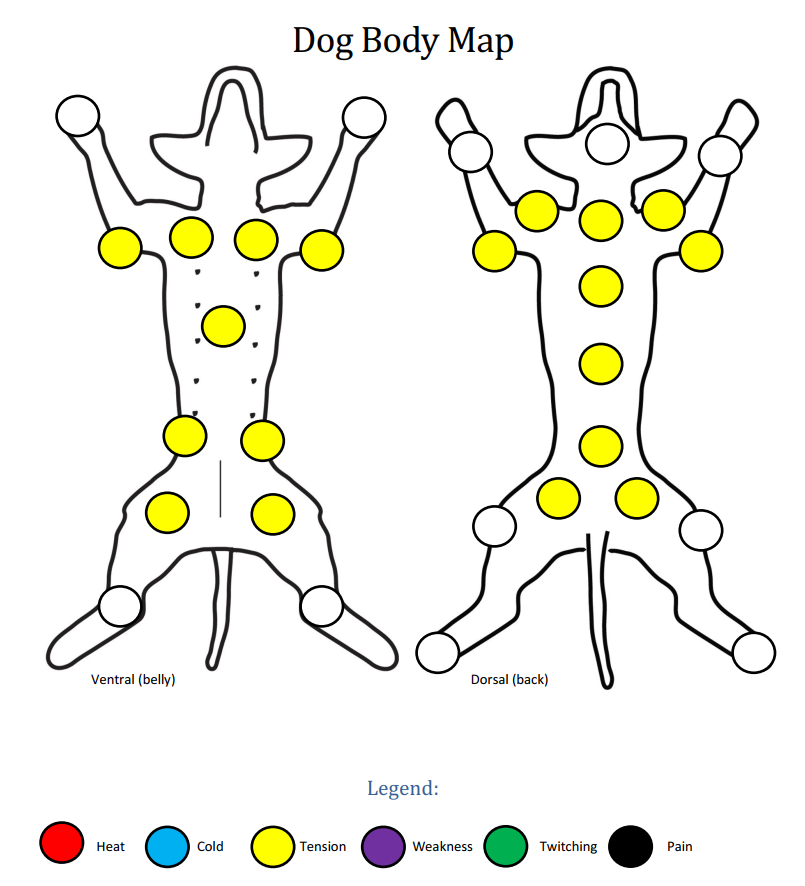
Weakness
For the purposes of our body map, this refers to muscle weakness that can be perceived when looking at a body part, such as a visibly smaller muscle as compared to the same area on the other side.
Weakness can also be felt under your hands such as smaller muscle, decreased muscle tone, flabby or soft tissue. It helps to compare opposite sides of the body.
In this case, the cause of muscle weakness is the wasting or loss of muscle tissue – muscle athrophy.
Atrophy can be caused by muscle disuse, nerve damage or disease. Most common causes for muscle atrophy are:
- Injury
- Surgery
- Neurological issues
- Aging
Common areas where you might find weakness:
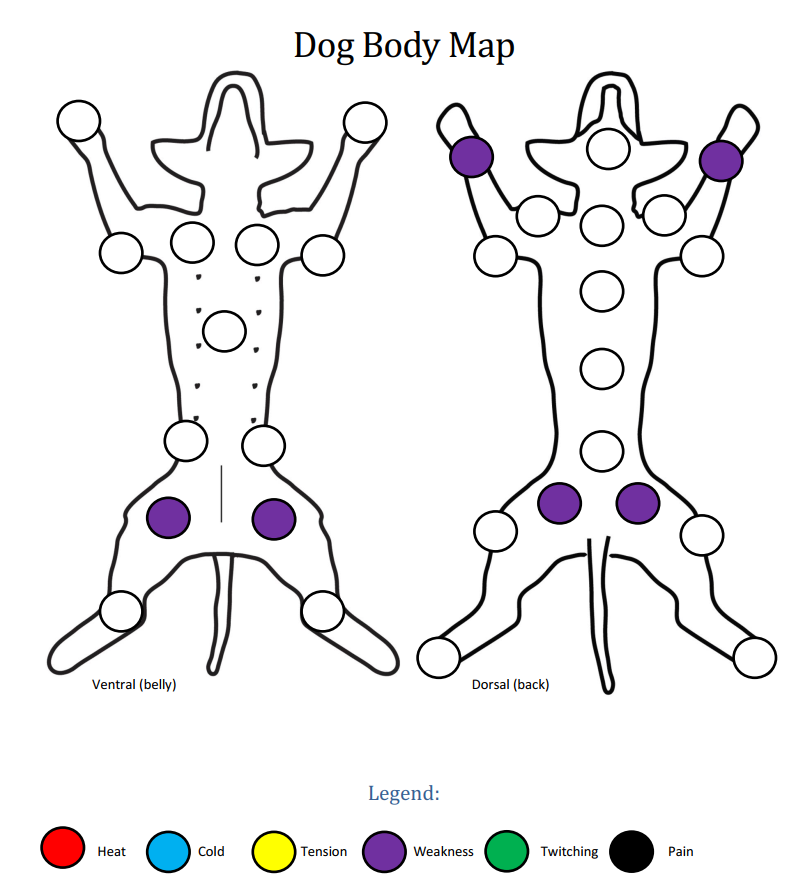
Twitching
Muscle twitching, also known as fasciculation, is common in fatigued or injured muscles. It helps to understand the difference between twichting, spasms or tremors, as all three are separate phenomena. To read more click here.
Muscle fasciculation is a momentary, brief twitch of muscle fibers, visible under the skin and can be felt under your fingers. It doesn’t move the whole muscle and is usually not painful. The most common causes for muscle twitching are:
- Fatigue
- Stress
- Muscle athrophy
- Neurological issues
Common areas where you might find twitching:
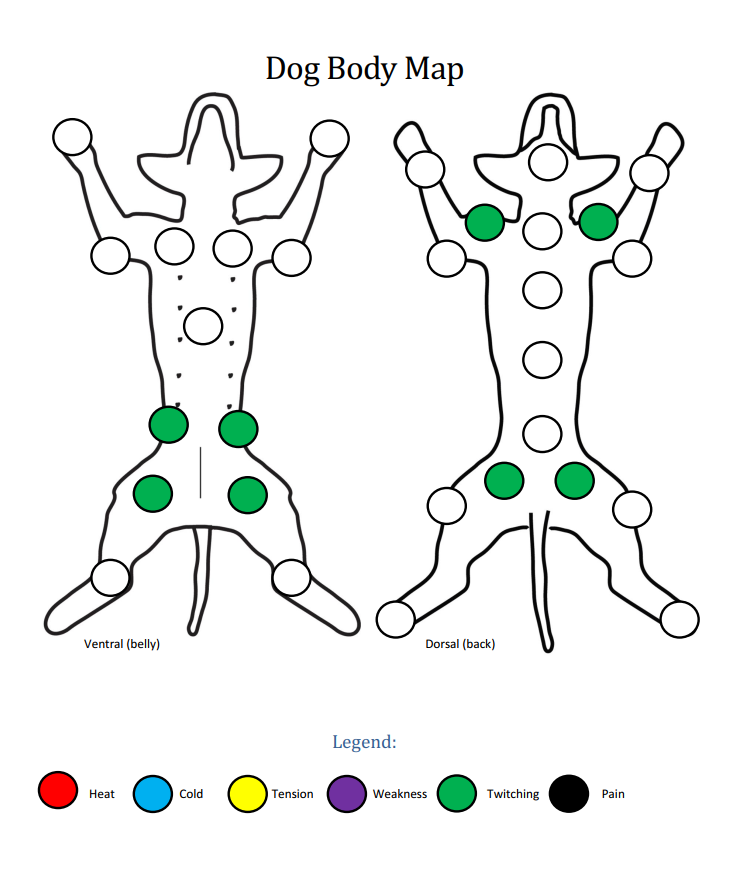
Pain
This is another very broad subject and you can read more about it here.
The way in which our dogs perceive, show and cope with pain is very complex and I encourage you to read more on the subject. We also need to recognize that pain is very much a multi-factorial and individual experience.
In general we deal with adaptive (acute) and mal-adaptive (chronic) pain. We can think of them as “good” and “bad” pain.
Acute pain is meant to protect the tissue from further damage after injury.
Chronic pain doesn’t serve a functional purpose. Acute pain can sometimes turn into chronic pain. Common causes for chronic pain:
- Injury
- Arthritis
- Spinal/nerve issues
Common areas where you might find pain:
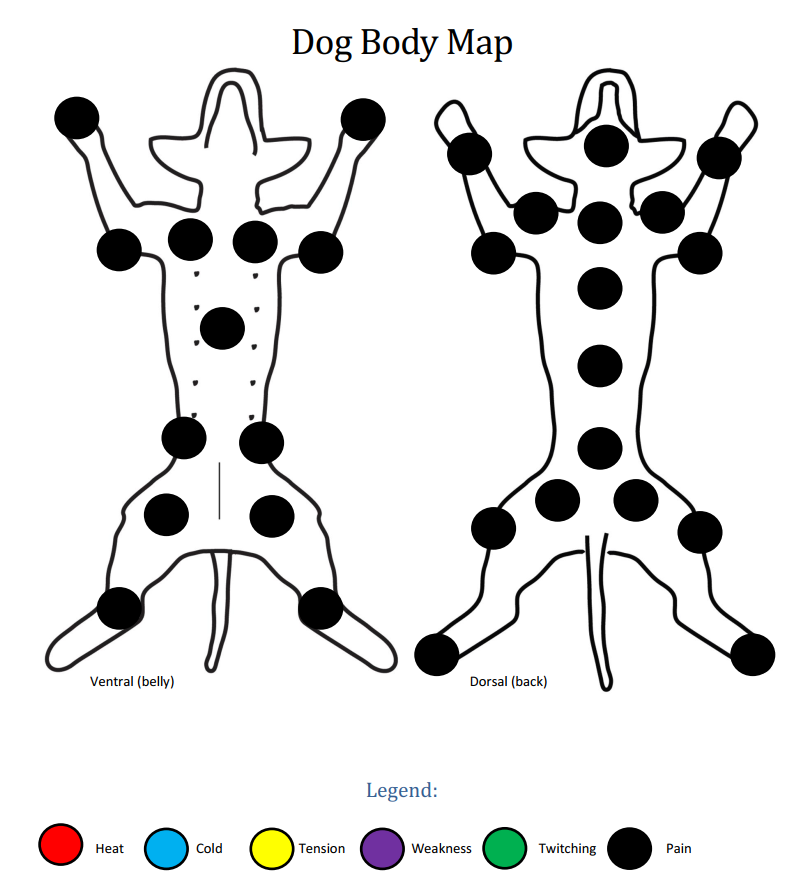
In Summary
Using the body map consistently will allow you to get to know what is normal for your dog. Discovering patterns and creating a baseline will help you quickly spot any suspiciuous or unsual signs that could be an early warning signs of trouble or potential injury.
Follow us on Instagram for more massage and wellness tips
